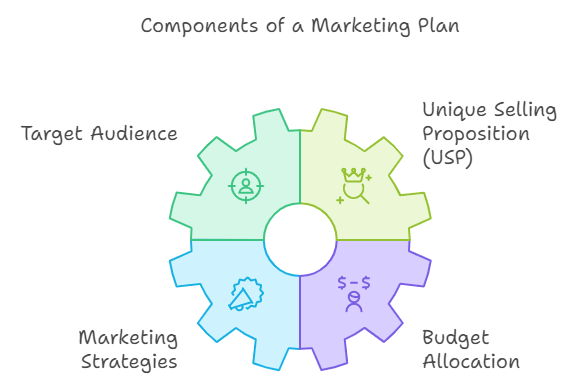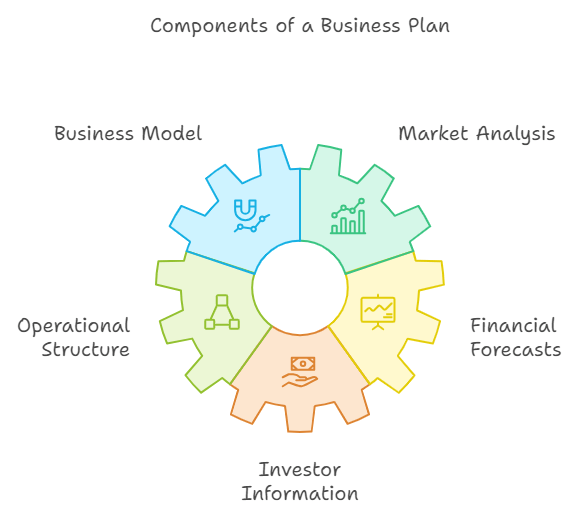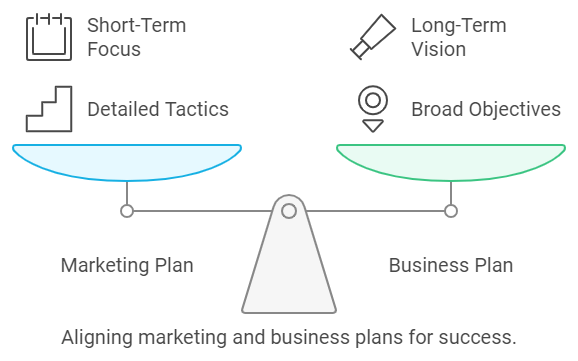Introduction to Marketing Plan and Business Plan
Every successful business starts with a clear plan, but not all plans serve the same purpose. Two of the most critical documents for any business are the marketing plan and the business plan. While both are essential for guiding a company’s growth, they have distinct roles in a business’s overall strategy.
A marketing plan is a tactical document that focuses on specific strategies to attract and retain customers. It outlines how a company will promote its products or services, reach its target audience, and differentiate itself from competitors. Essentially, a marketing plan is about communicating the brand’s value and driving sales in a competitive marketplace.
On the other hand, a business plan offers a broader view of the company. It covers all aspects of the business, including financials, operations, market positioning, and long-term goals. A business plan is designed to give investors, stakeholders, and internal management a comprehensive roadmap for how the company will operate and grow.
In this article, you will learn the key differences between these two plans, what each document should include, and how they work together to ensure your business’s success.
1. Purpose and Focus
The primary difference between a marketing plan and a business plan lies in their purpose and focus.
Marketing Plan:
The marketing plan is customer-centric. Its main focus is on how the business will attract, engage, and retain customers. The purpose of this plan is to lay out specific tactics that will promote the product or service to the target audience. It answers questions like:
- Who is the target customer?
- What strategies will the business use to reach them?
- How will the product be positioned in the market to stand out from competitors?
This plan is often shorter-term, focusing on marketing campaigns and initiatives over the next year or so. It’s a tactical document that translates business goals into actionable marketing strategies.
Business Plan:
The business plan takes a broader approach, offering a strategic view of the company’s entire operation. This document outlines the overall business model, financial goals, and long-term vision. It provides a comprehensive blueprint for how the business will achieve its objectives, including:
- Revenue projections and financial forecasts
- Operational strategies
- Product development
- Market analysis and growth opportunities
A business plan is typically used to secure funding, attract investors, or guide internal decision-making at a high level. While the marketing plan is one piece of the puzzle, the business plan covers all areas, ensuring that every part of the business works together toward long-term success.
2. Components of a Marketing Plan vs. Business Plan
Marketing Plan:

A marketing plan includes several key components that directly relate to the customer experience and promotional strategies. These include:
- Target Audience: Identifying who the ideal customers are and segmenting them based on demographics, behaviors, and needs. This helps ensure that marketing efforts are directed toward the right people.
- Unique Selling Proposition (USP): The USP explains what makes your product or service different from the competition. It highlights the unique value your business offers and why customers should choose you over others.
- Marketing Strategies: This section details the tactics and channels that will be used to promote the business. It could include content marketing, social media advertising, SEO, PPC campaigns, and email marketing. Each strategy is designed to move the target audience closer to making a purchase or engaging with the brand.
- Budget Allocation: The marketing plan also includes a budget breakdown, indicating how much money will be spent on each strategy or campaign. This ensures that resources are allocated effectively to maximize impact.
Business Plan:

A business plan is a much broader document that covers the entire business. It typically includes the following components:
- Business Model: A clear explanation of how the business will generate revenue and operate profitably. This includes details about the product or service, pricing models, and delivery methods.
- Market Analysis: A deep dive into the market landscape, identifying trends, customer needs, and competitor strategies. This analysis helps validate the business idea and demonstrates that there’s a market demand for the product or service.
- Operational Structure: This section outlines how the business will be organized and managed, from production to distribution. It includes details about key personnel, supply chain management, and operational processes.
- Financial Forecasts: A detailed financial plan, including projected income statements, cash flow forecasts, and balance sheets. This section is particularly important for investors, as it shows how the business plans to grow profitably over time.
- Investor Information: If the business plan is being used to secure funding, it will include sections specifically designed to appeal to investors. This may include information on the amount of capital needed, how the funds will be used, and the expected return on investment (ROI).
While the marketing plan is focused on how to win customers, the business plan provides the overarching framework for how the company will operate and grow. Together, these two documents form the foundation of a strategic, successful business strategy.
3. Time Frame
The time frame of a marketing plan and a business plan differs significantly based on their respective focuses and goals.
Marketing Plan:
A marketing plan typically focuses on the short term, outlining campaigns and initiatives over a period of 6 to 12 months. This short-term focus allows businesses to stay agile and adjust their marketing strategies based on performance data and changing market conditions. Marketing plans are designed to address immediate goals such as increasing brand awareness, boosting website traffic, or launching a new product.
Because marketing trends and customer behaviors evolve quickly, businesses revisit their marketing plans more frequently—usually every quarter or annually—to ensure they stay aligned with business objectives and market realities.
Business Plan:
A business plan, on the other hand, has a much longer time frame. It usually covers a period of 3 to 5 years, providing a long-term vision for the business. The goals outlined in a business plan are broader and take more time to achieve, such as reaching a specific revenue target, expanding into new markets, or securing venture capital funding.
The long-term nature of a business plan makes it less likely to change frequently, though updates may occur when there are major shifts in business strategy, market conditions, or financial status. While the marketing plan is a tactical guide, the business plan provides a strategic roadmap for sustainable growth over time.
4. Target Audience for Each Plan
Another key distinction between a marketing plan and a business plan lies in their intended audiences.
Marketing Plan:
The marketing plan is primarily an internal document, intended for the marketing team, sales staff, and other internal stakeholders who are responsible for executing the marketing strategy. It may also be shared with management to secure approval for campaigns, budget allocations, and resource needs. The goal of the marketing plan is to provide clear direction on how the company’s marketing efforts will achieve the business’s short-term goals.
Occasionally, the marketing plan may be presented to external stakeholders, such as partners or investors, to show how the company plans to increase brand visibility and sales.
Business Plan:
The business plan has a broader audience, often including external parties. It is typically created for investors, lenders, and potential business partners, as well as key internal stakeholders like company executives. The business plan is used to secure funding, attract investors, and communicate the company’s long-term strategy.
It provides a comprehensive view of the business’s overall goals, operational structure, financial health, and market position. For external stakeholders, the business plan demonstrates the company’s potential for growth and profitability, making it a crucial tool for gaining financial support and buy-in.
5. Financial Planning and Projections
The financial section is where the marketing plan and the business plan differ most clearly in terms of detail and scope.
Marketing Plan:
A marketing plan includes a marketing budget that outlines the costs associated with marketing activities, such as advertising, content creation, social media, events, and promotional materials. It also breaks down how much will be allocated to each marketing channel, like digital marketing, print ads, or influencer campaigns.
While the marketing plan provides a budget to guide marketing expenditures, it typically does not include in-depth financial forecasts such as revenue projections or profitability estimates. Instead, the marketing budget is aligned with the broader business goals set out in the business plan, but the detailed financial impact of marketing efforts is usually tracked over time and analyzed in conjunction with sales and business performance.
Business Plan:
A business plan provides a comprehensive financial forecast, often including income statements, balance sheets, and cash flow projections. This detailed financial planning is essential for attracting investors, securing loans, or demonstrating the business’s long-term viability.
Financial projections in the business plan typically include:
- Revenue Projections: Forecasted income from sales, often broken down by product line or service.
- Income Statement: A projection of profit and loss, detailing expected revenue, cost of goods sold, operating expenses, and net income over several years.
- Balance Sheet: A snapshot of the company’s assets, liabilities, and equity at a specific point in time.
- Cash Flow Forecast: Projections of the company’s cash inflows and outflows, which help ensure the business can maintain liquidity and fund future operations.
These financial projections help investors and lenders understand the company’s growth potential and financial stability. Unlike the marketing plan’s focus on marketing expenditures, the business plan provides a holistic view of the business’s financial health and future profitability.
By understanding the time frame, target audience, and financial focus of both a marketing plan and a business plan, businesses can create well-rounded strategies that address both short-term needs and long-term goals.
6. Strategic vs. Tactical Approach
The marketing plan and the business plan also differ in terms of strategic and tactical approaches.
Marketing Plan:
A marketing plan is more tactical, focusing on specific actions and methods to achieve short-term marketing goals. It details the “how” of marketing: how the company will promote its products, how it will reach its target audience, and how it will achieve brand recognition and lead generation.
For example, a marketing plan might outline a social media campaign, the use of email newsletters, or paid advertising strategies to boost traffic or sales. These tactics are designed to address the immediate needs of the business, making the marketing plan action-oriented and responsive to market conditions.
Business Plan:
The business plan is more strategic, outlining the company’s long-term vision and objectives. It addresses the “what” and “why” of the business, such as what the company aims to achieve in terms of growth, profitability, and market share, and why the business model will succeed.
The business plan provides the framework for broader decisions, such as expanding into new markets, launching new products, or securing funding. It acts as a blueprint that guides the company’s direction for the next several years and ensures that all departments, including marketing, are aligned with the overall vision.
7. How Marketing Plan and Business Plan Work Together

While the marketing plan and business plan serve different purposes, they are complementary. The marketing plan supports the business plan by providing the detailed tactics needed to achieve the broader business objectives. For instance, if the business plan includes a goal to increase revenue by 20% over the next year, the marketing plan outlines the specific campaigns and strategies to help meet that target.
Both plans should be aligned to ensure consistency. A strong business plan informs the marketing strategy, while an effective marketing plan ensures that the business plan’s goals are being executed on the front lines. Together, they create a cohesive, strategic approach that ensures all aspects of the business work in harmony toward achieving long-term success.
Conclusion
A well-rounded understanding of the marketing plan and business plan is crucial for business owners and entrepreneurs looking to launch or grow their businesses. While the business plan provides a strategic roadmap for the company’s overall goals, the marketing plan offers the tactical steps needed to achieve those goals by attracting and retaining customers. Both documents serve as essential tools that, when combined, create a comprehensive strategy for business success.
For those starting out or refining their strategy, using a free marketing plan template can be an excellent way to outline your marketing objectives and align them with the broader goals outlined in your strategic marketing plan. By understanding the differences between these two essential documents and how they work together, businesses can be well-prepared to tackle both short-term challenges and long-term growth.

Juan is a Digital Advertising / SEM Specialist with over 10 years of experience with Google AdWords, Bing Ad Center, Facebook, LinkedIn, Google Analytics, HTML, and WordPress. He is a co-founder of Sheaf Media Group and has work in several online advertising projects for retail, automotive, and service industries. Additionally, Juan holds a bachelor’s degree in Psychology and has a deep interest in the science of human behavior which he attributes as the key factor for his success in the advertising world.


